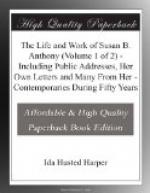The next day on the streets, so the letters say, everybody was exclaiming, “Miss Anthony is the smartest woman who ever has been in Canajoharie.” Soon afterwards the school closed and, after spending the summer visiting eastern relatives and friends, Miss Anthony returned to Rochester in the autumn of 1849. The thing she remembers most vividly is how she reveled in fruit. All the young orchards her father had planted were now bearing, including a thousand peach trees, and for the first time in her life she had all the peaches she wanted, and “lived on them for a month.”
The years of 1850 and 1851 Daniel Anthony conducted his insurance business in Syracuse and Susan remained at home, taking entire charge of the farm, superintending the planting of the crops, the harvesting and the selling. She also did most of the housework, as her mother was in delicate health, her sister was teaching school and both brothers were away. In the winter of 1852, she went into a school in Rochester as supply for three months. She found, however, that her taste for teaching was entirely gone, her work was without inspiration, her interest and sympathy had become enlisted in other things. She longed to take an active part in the two great reforms of temperance and anti-slavery, which now were absorbing public attention; she could not endure the narrow and confining life of the school-room, and so, in the spring, she abandoned teaching forever, after an experience of fifteen years.
[Footnote 9: Nearly fifty years afterwards, when Mr. Hagar was at the head of the Girls’ High School, in Salem, Mass., Miss Anthony visited him and was most cordially invited to address his pupils “on any subject she pleased, even woman suffrage.”]
[Footnote 10: The play for this occasion was written by James Arkell, father of W.J. Arkell, proprietor of the Judge. He was a pupil in the boys’ department of the old academy.]
CHAPTER V.
Entrance into public life.
1850—1852.
Ill the conditions were such as to make it most natural for Miss Anthony, when she reached the age of maturity, to adopt a public career and go actively into reform work, and especially to enter upon that contest to secure equal rights for those of her own sex, which she was to wage unceasingly for half a century. Her father’s mother and sister were “high seat” Quakers, the latter a famous preacher. Her mother’s cousin, Betsey Dunnell White, of Stafford’s Hill, was noted as the only woman in that locality who could “talk politics,”




